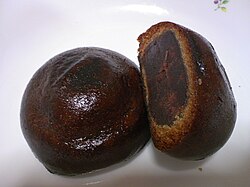Manjū
You can help expand this article with text translated from the corresponding article in Japanese. (October 2012) Click [show] for important translation instructions.
|
This article needs additional citations for verification. (November 2007) |
 | |
| Type | Wagashi |
|---|---|
| Place of origin | Japan |
| Region or state | East Asia |
| Main ingredients | Flour, rice powder, buckwheat, red bean paste |
Manjū (
History[edit]
Manju is a traditional Japanese flour-based pastry (instead of rice-based like mochi). During the Kamakura period (1185-1333), Japanese Buddhist monks who studied in the Song Dynasty brought the culture of the tea ceremony to Japan, and the custom of eating confections with tea began in Japan.
The monks also introduced tenshin (
Varieties[edit]


Of the myriad varieties of manjū, some more common than others.
- Matcha (green tea) manjū is one of the most common. In this case, the outside of the manjū has a green tea flavor and is colored green.
- Mizu (water) manjū is traditionally eaten in the summertime and contains a flavored bean filling. The exterior of the mizu manjū is made with kuzu starch, which gives the dough a translucent, jelly-like appearance.[2]
- Also, manjū can have different flavored fillings, such as orange-flavored cream.
- As is the case with many Japanese foods, in some parts of Japan, one can find manjū unique to that region, such as the maple leaf-shaped momiji manjū in Hiroshima and Miyajima.
- The regional variety of the Saitama prefecture is called Jumangoku manjū.
See also[edit]
- Daifuku
- List of Japanese desserts and sweets
- Mamador
- Mantou (
饅頭 , Chinese plain steamed bun), etymologically the origin of the word, although in modern Chinese the term for filled buns is baozi - Manti (Turkic) and mandu (Korean), filled dumplings with the names being cognate with mantou and manjū
- Momiji Manju
- Nikuman
- Tangyuan
- Kozhukkatta is a steamed dumpling made from rice flour, with a filling of grated coconut, jaggery, or chakkavaratti in South India.
References[edit]
- ^ a b
駆 け足 でたどる和菓子 の歴史 (in Japanese). National Diet Library. Archived from the original on 22 February 2024. Retrieved 22 February 2024. - ^ Schilling, Christine (2007). "Translator's Notes." in Kirishima, Takeru (2002). Kanna Volume 2. California: Go! Comi (Go! Media Entertainment, LLC). ISBN 978-1-933617-56-5
External links[edit]
 Media related to Manjū at Wikimedia Commons
Media related to Manjū at Wikimedia Commons- Kashiwaya (Japanese)
- Kashiwaya Usukawa Manju(Instagram)
